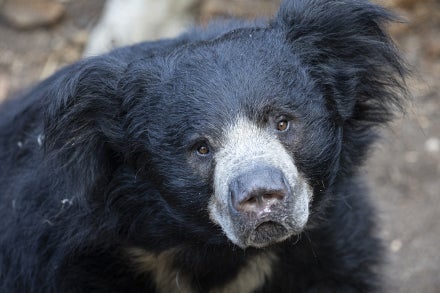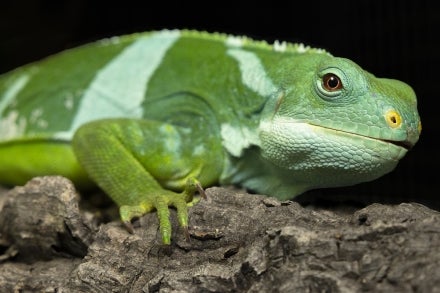
Peaceful scenes unfold as frogs leap across babbling streams, black feathered birds soar through lush forest, and desert dwellers burrow deep underneath our feet. These are the sights and sounds that ground us to our surrounding world. When we immerse ourselves in nature, we’re reminded of an undeniable truth: people, wildlife, and the planet we all share are inextricability connected. Healthy, thriving ecosystems rely on balance. When that balance is disrupted, those ecosystems are at risk. Today, many species unfortunately face growing challenges that inch them closer to disappearing altogether, creating devastating ripple effects for the habitats they share.
With wildlife allies like you by our side, we work to restore this necessary and delicate balance. Since our founding over a century ago, we’ve honed our expertise in wildlife care and conservation to reintroduce over 44 species back into their native landscapes across the globe. Each reintroduction milestone is a step toward a brighter and more sustainable future for wildlife everywhere.
In 1982 there were only 22 California Condors remaining on Earth. Today, there are over 560 condors with more than half soaring over the Southwest.
Reintroductions at Home
Our two leading wildlife parks, the San Diego Zoo and San Diego Zoo Safari Park, are nestled into the heart of the American Southwest. This cross-border region spans from coast to desert across the southwestern United States and northern Mexico. It incorporates widely varied ecosystems, including lush wetlands, rugged forests, rolling grasslands, and towering mountains. Here, in the place we call home, we work with countless species to restore populations of vulnerable and endangered wildlife through our Southwest Conservation Hub.
In 1982, there were only 22 California condors remaining on Earth. Their future was uncertain until an extraordinary effort kicked off their remarkable comeback story. Together with our partners, we founded the groundbreaking California Condor Recovery Program to help restore flourishing condor populations across the region. Since the early days of the program, we’ve continued to incubate, hatch, and raise condors at the Safari Park for reintroduction at six release sites across California, Arizona, and Baja California, Mexico. The recovery these vultures have since made is nothing short of astonishing. Today, there are over 560 California condors, with more than half soaring over Southwest coastlines, mountains, and deserts, reconnected to the landscapes from which they once almost disappeared entirely.
Pacific pocket mice are “ecosystem gardeners,” enriching the soil and stabilizing the sandy coastal scrublands of Southern California.
The Safari Park also serves as the headquarters for conservation breeding programs focused on two other threatened species—burrowing owls and Pacific pocket mice. While they indeed have wings, petite burrowing owls spend most of their lives underground. They’re integral to their open grassland habitats and help control populations of insects and small rodents. But due to widespread development and urban sprawl in Southern California, burrowing owls have become endangered. We’re working to establish self-sustaining breeding populations by reintroducing these little locals into protected native habitats, giving them the bright future they deserve.
Likewise, the Pacific pocket mouse is making a mighty comeback. They’re endemic to Southern California and were thought for decades to be extinct. These “ecosystem gardeners” enrich the soil and stabilize the sandy coastal scrublands they call home. Since 2012, we’ve been reintroducing them into protected areas to establish new populations, bringing this tiny, endangered mouse is one step closer to recovery.
We use "headstarting" to give Mojave desert tortoises a helping hand to succeed in native habitats.
Reintroduction often requires specialized methods such as “headstarting.” This innovative approach prepares wildlife to succeed in native habitats by giving them a helping hand, tailored to address each species’ unique needs. For young and vulnerable Mojave desert tortoises, they’re protected and cared for after hatching and until they’re large and strong enough to survive in native habitats on their own. Adult female tortoises can also be brought into a protected facility, where they’re offered private burrows for safe egg laying or protection from devastating heat waves. Yes, with increasing global temperatures it can even get too hot for a tortoise native to the desert!
Over the last 15 years, we've reintroduced more than 11,000 mountain yellow-legged frogs into their historic range.
Endangered mountain yellow-legged frogs undergo a similar headstarting process as it’s no small challenge to live in their high elevation streams and lakes. At the Safari Park, tadpoles are raised while they gradually metamorphosize into larger, hardier froglets. As they grow bigger and stronger, they become better equipped to endure strong currents and evade predators in their native habitats. Over the last 15 years, we’ve translocated more than 11,000 mountain yellow-legged frogs, reestablishing sustainable populations in their historic range and helping secure their future.
Plant species need reintroduction efforts, too. The iconic but critically endangered Torrey pine is only found along a short stretch of central San Diego County coastline. They’re crucial to shaping this seaside environment, with their vast root systems stabilizing the soil and protecting the surrounding windswept cliffs. But due to increasing threats including drought and bark beetle infestation, this pine’s population has been drastically shrinking. To put down roots for their future, our Plant Conservation team has planted hundreds of seedlings throughout their coastal home.
Torrey pines are only found along a short stretch of coastline in San Diego County.
To Distant Shores
Stretching from the western coasts of the Americas, to the Arctic and Antarctic, and all the way to Asia and Australia, the Pacific Ocean is dotted with thousands of islands, each teeming with dynamic ecosystems. These islands are home to fascinating species, including birds and amphibians found nowhere else on Earth—many of which are critically endangered. Collaboration with partners in these faraway places is key to saving wildlife and restoring vital ecological balance.
Just like desert tortoises in the Mojave, juvenile aga (Mariana crows) on the island of Rota are brought into an on-island care facility for up to two years to help them succeed in native habitats. In this protected environment, they safely grow away from the reach of predators, while learning how to hunt and live in the forests. Through this crucial program led by partners in our Pacific Islands Conservation Hub, over 80 critically endangered aga have been reintroduced back into Rota’s lush island landscapes—slowly but surely stabilizing populations.
Headstarting is also used to help aga (Mariana crows) thrive in native habitats. Photo Credit: Phil Harmon
About 4,000 miles from Rota on the Hawaiian islands, ʻalalā are more than just an endemic bird. They support the islands’ rich biodiversity and are also significant to Hawaiian people, revered as ʻaumākua or a kindred guardian. Until recently, they’d also been extinct in the wild for more than 20 years. With our partners in Hawaiʻi, we’re swooping toward a more sustainable future with the recent milestone reintroduction of five ʻalalā. Now they’re soaring through the trees of the islands once again.
Until recently, ʻalalā had been extinct in the wild for more than 20 years.
Far-Reaching Hope
Decades ago, the last wild horse had disappeared from the sweeping grassland plains of its native habitat across the vast Asian steppe. This ignited a global movement to save the Przewalski’s horse. Since 1979, we’ve been collaborating with a team of international conservation partners to lead the way in breeding, conservation genetics programs, and the reintroduction of this critically endangered horse. These groundbreaking developments have helped restore crucial genetic diversity to the global population and strengthened the ability for future generations to thrive. Today, thanks to these collaborative efforts, herds once again roam these dynamic grasslands, showing us that anything is possible when we come together for wildlife.
Herds of Przewalski's horses are roaming the vast Asian steppe once again after being extinct in the wild for decades.
In the dense Amazon rainforest, conservationists face significant challenges in their fieldwork. One hurdle has been transporting samples collected from the field to distant labs, often requiring hundreds of miles of travel through remote, rugged landscapes. This delays the samples’ processing and risks their integrity while slowing conservation progress. Now there’s a one-of-a-kind laboratory in the heart of the Amazon that’s changing everything. This hyperlocal field station makes science more accessible and efficient, enabling researchers to preserve samples and gain insights faster without spending days trekking across rough terrain. Teams are now able to use DNA barcoding to easily and accurately identify primates rescued from the illegal wildlife trade, thus informing appropriate areas for their reintroduction through our Amazonia Conservation Hub.
Critically endangered black rhinos are now roaming an expansive, new 58,000-acre sanctuary in Laikipia County, Kenya.
On the Kenyan savanna, critically endangered black rhinos are making a triumphant return. Years of collaborative conservation efforts created a positive but perplexing problem. While the species remains critically endangered, populations have started to recover, leading all existing sanctuaries across Kenya to reach nearly full capacity. So our partners through our Savanna Conservation Hub established a new 58,000-acre sanctuary in Laikipia County, Kenya. For the first time in 50 years, black rhinos are grazing this area of their native rangelands once more, making an incredible comeback and restoring balance to a place where they once thrived.
This handful of success stories are only a small portion of the species we’ve helped reintroduce across the globe. Reflecting on this progress in wildlife conservation is a powerful reminder of how far we’ve come—and how far we still have to go. For over a century, we’ve taken action for vulnerable and endangered wildlife to renew hope and help ecosystems flourish. Every day, we’re working to restore balance to safeguard the future for people, wildlife, and the planet we all share. And the support of allies like you makes it all possible. Together we’re making a difference for wildlife, one day at a time.
Discover more about how we’re making a difference for wildlife worldwide through our eight Conservation Hubs.













